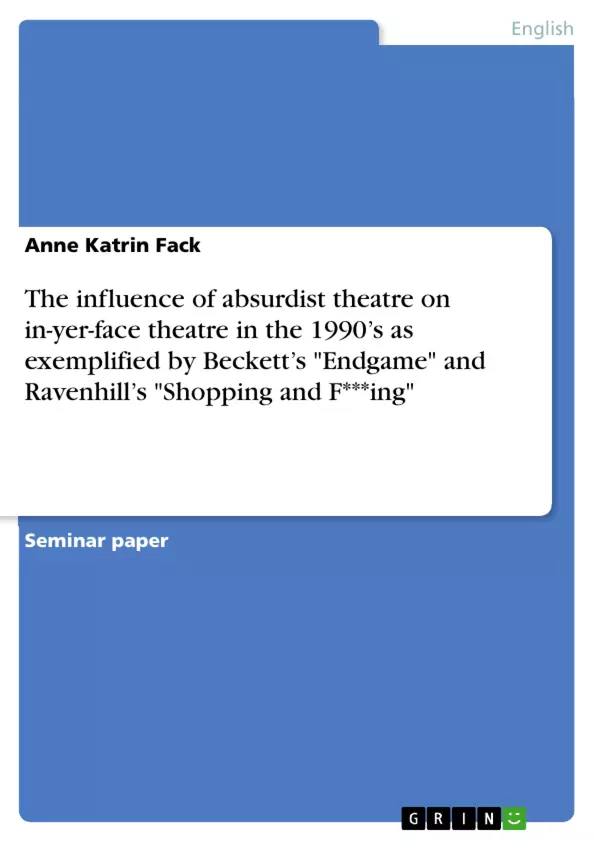“In-Yer-Face Theatre is to the 1990s what absurdism was to the 1950s”
In the following paper, I’d like to investigate whether this statement is true or if both movements should be seen as two different theatre forms without any connection.
As a basis of my investigations serves Agnes M. Kitzler’s study about the influence of Absurdist Theatre on Contemporary In-Yer-Face Theatre (Kitzler, 2011) as well as Aleks Sierz’ book on In-Yer-Face-Theatre (Sierz, 2001) and Martin Esslin’s book on the Theatre of the Absurd (Esslin, 2001). I will mostly try to give a general overview about similarities and differences between absurdism and In-Yer-Face Theatre before I give distinct examples of Samuel Beckett’s play Endgame and Mark Ravenhill’s Shopping and F***ing and finally come to a conclusion if In-Yer-Face Theatre is to the 1990s what absurdism was to the 1950s or not.
I firmly believe that as this paper is limited to seven until eight pages it is more important to give a general overview which is more effective to answer the question whether both movements show similarities or not. However, I think it is important to undertake several aspects a closer examination in a broader study, which could be, for example, a bachelor thesis.
Table of Contents
- Introduction
- Theatre of the Absurd and In-Yer-Face Theatre: a Comparison
- In-Yer-Face Theatre
- Theatre of the Absurd
- Comparing Absurdist Theatre and In-Yer-Face Theatre
- Analysing Beckett's Endgame and Ravenhill's Shopping and F***ing
- Characters conception
- Language and dialogue
- The expression of the body
- Conclusion
Objectives and Key Themes
This paper aims to investigate whether In-Yer-Face Theatre is comparable to absurdist theatre, specifically focusing on the influence of the latter on the former in the 1990s. The paper will analyze the similarities and differences between the two movements, drawing on key works such as Samuel Beckett's "Endgame" and Mark Ravenhill's "Shopping and F***ing."
- Comparison of In-Yer-Face Theatre and Absurdist Theatre
- Analysis of character conception, language, and body expression in the chosen plays
- Exploration of the rejection of traditional dramatic structures
- Examination of the emotional and psychological state of characters in both movements
- Discussion of the use of shocking content and its impact on the audience
Chapter Summaries
The introduction provides context for the investigation, highlighting the potential connection between In-Yer-Face Theatre and absurdism. Chapter 2 delves into a detailed comparison of the two theatrical movements, outlining their core characteristics and differences. This chapter highlights the rejection of traditional dramatic conventions in both forms, emphasizing the lack of traditional plots, characterizations, and dialogues.
The chapter also explores how both movements engage with the audience through shocking content and emotional confrontation, creating a sense of discomfort and disorientation. It examines the emotional and psychological state of characters in both movements, showcasing their struggles with meaninglessness, existential fear, and the inability to connect with others. Finally, Chapter 2 concludes by emphasizing the striking parallels between the two movements, suggesting a potential influence of absurdist theatre on In-Yer-Face Theatre.
Keywords
The main keywords and focus topics of this paper include In-Yer-Face Theatre, Absurdist Theatre, Samuel Beckett, Mark Ravenhill, "Endgame," "Shopping and F***ing," characterization, dialogue, body expression, emotional confrontation, shocking content, and the rejection of traditional dramatic structures.
- Citar trabajo
- Anne Katrin Fack (Autor), 2017, The influence of absurdist theatre on in-yer-face theatre in the 1990’s as exemplified by Beckett’s "Endgame" and Ravenhill’s "Shopping and F***ing", Múnich, GRIN Verlag, https://www.grin.com/document/377541



